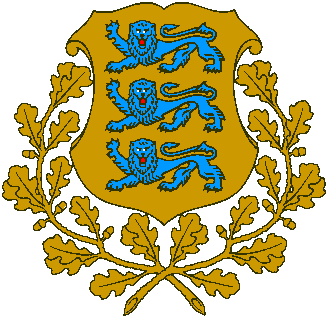
by Ivan Sache, 22 Febuary 2002

Last modified: 2002-04-12 by dov gutterman
Keywords: estonia | lion | leopard |
Links: FOTW homepage |
search |
disclaimer and copyright |
write us |
mirrors

by Ivan Sache, 22 Febuary 2002
See also:
The colors of the great and small coat of arms are blue
(PANTONE 285 C) and golden.
The Great and Small State Coats of Arms of the Republic of
Estonia were confirmed by the Riigikogu by a Lawadopted on June
19, 1925, which entered into force on the territory of
the Republic of Estonia on July 21, 1925.
According to the description in that Law, the coat of arms can be
in two shapes, a large coat of arms or a small coat of arms. The
large national coat of arms has three blue lions (or according to
some interpretations, leopards) on a shield with a gold base. The
shield is surrounded on three sides by a wreath of golden oak
leaves. The smaller coat of arms lacks this.
Upon the passing of the Law, proposals were made in the Riigikogu
on possible interpretations of the images on the coat of arms. A
consensus was reached on the suggestions offered by Leopold
Raudkepp:
The golden-yellow shield with three blue lions was used for the first time as the corporate seal of the association of Tartu and Viruvassals in 1284. Later